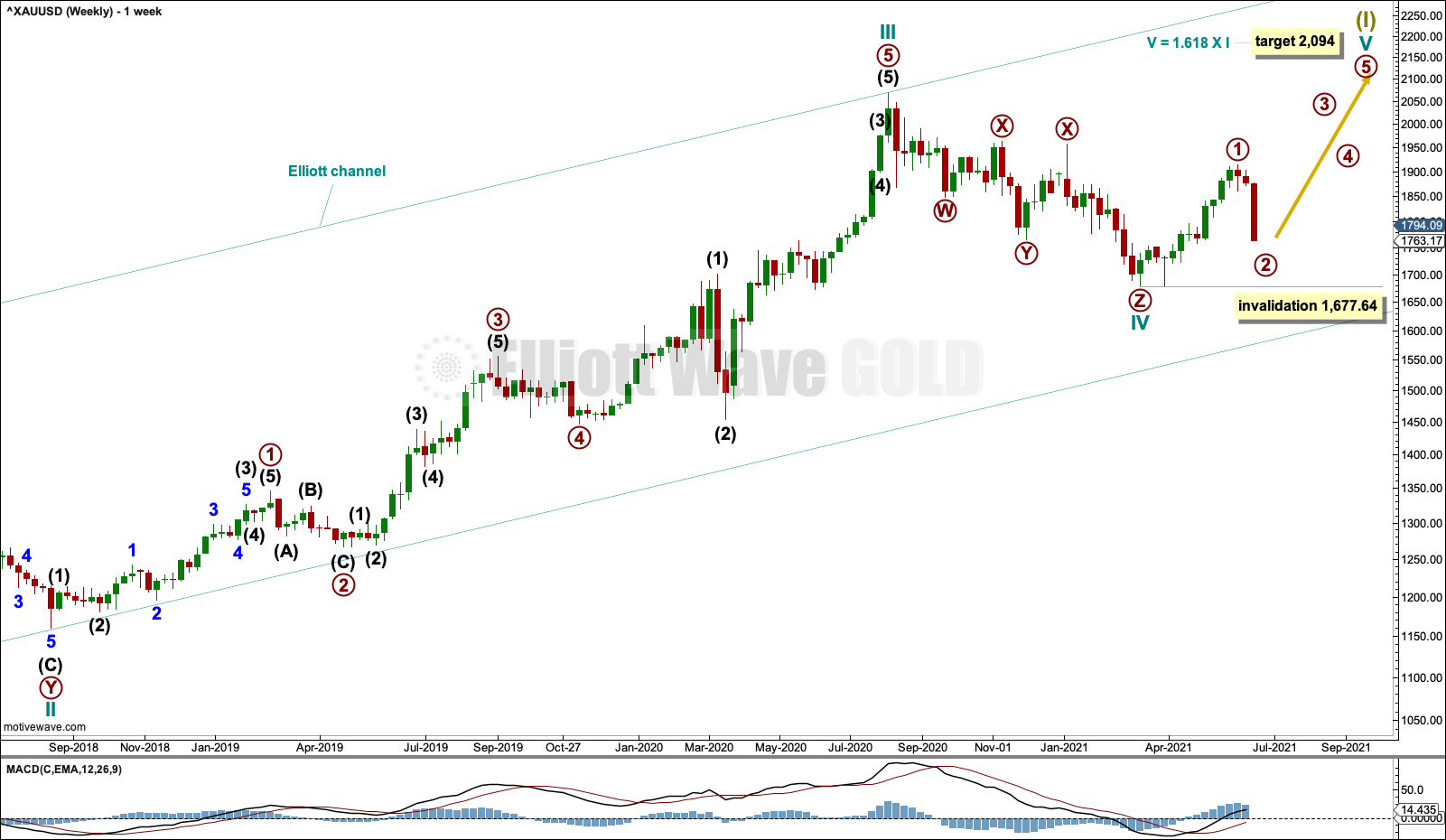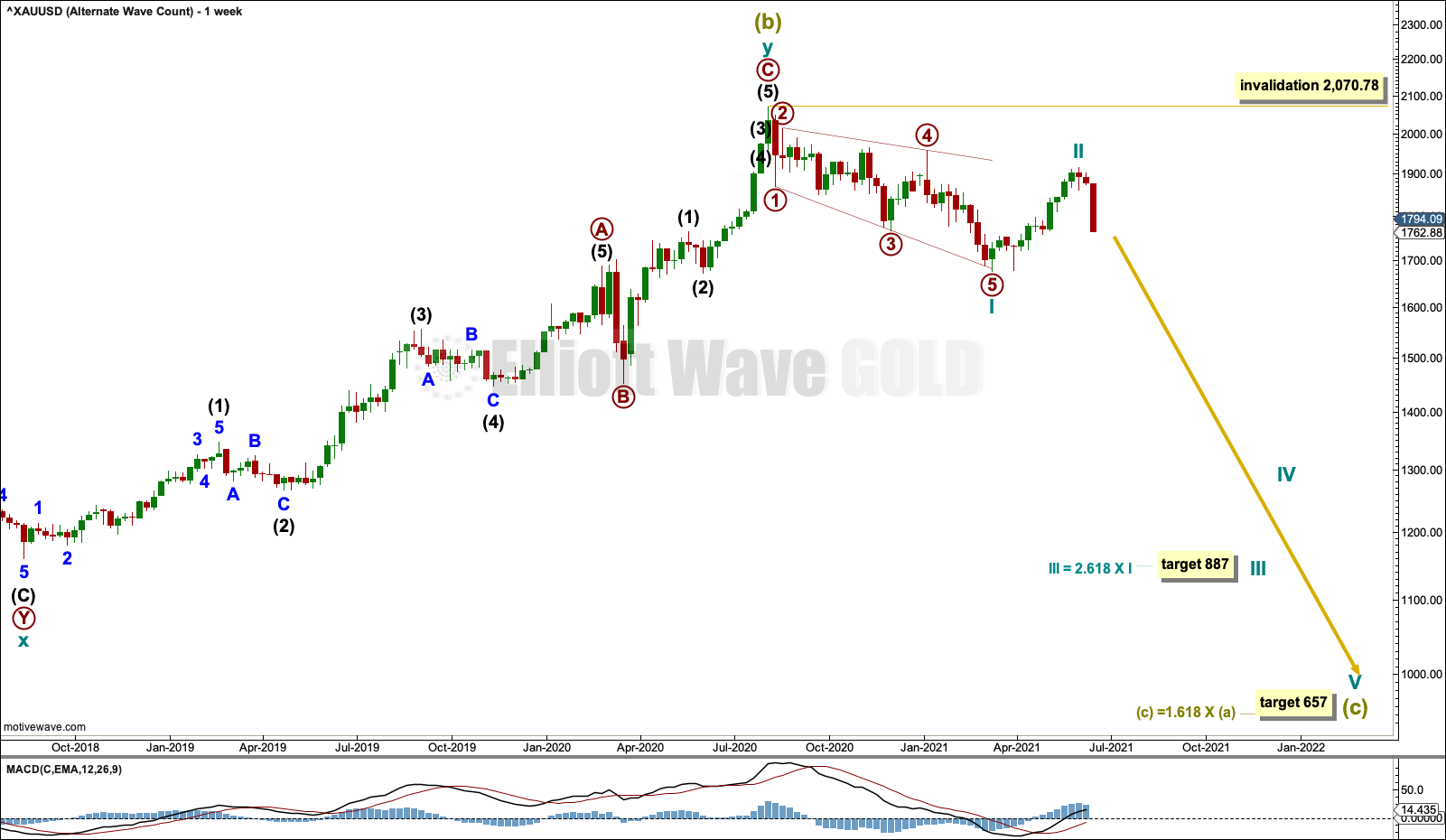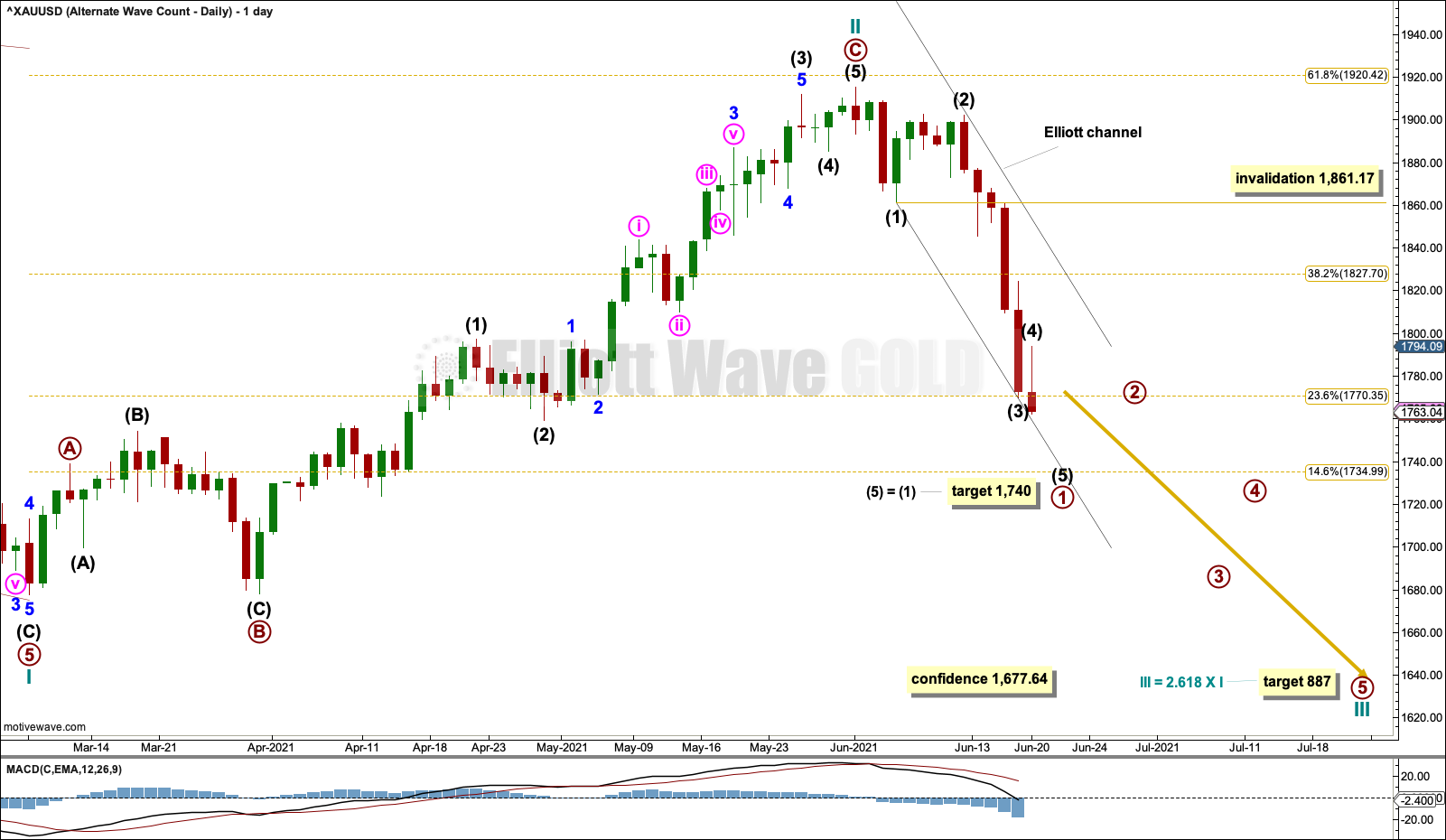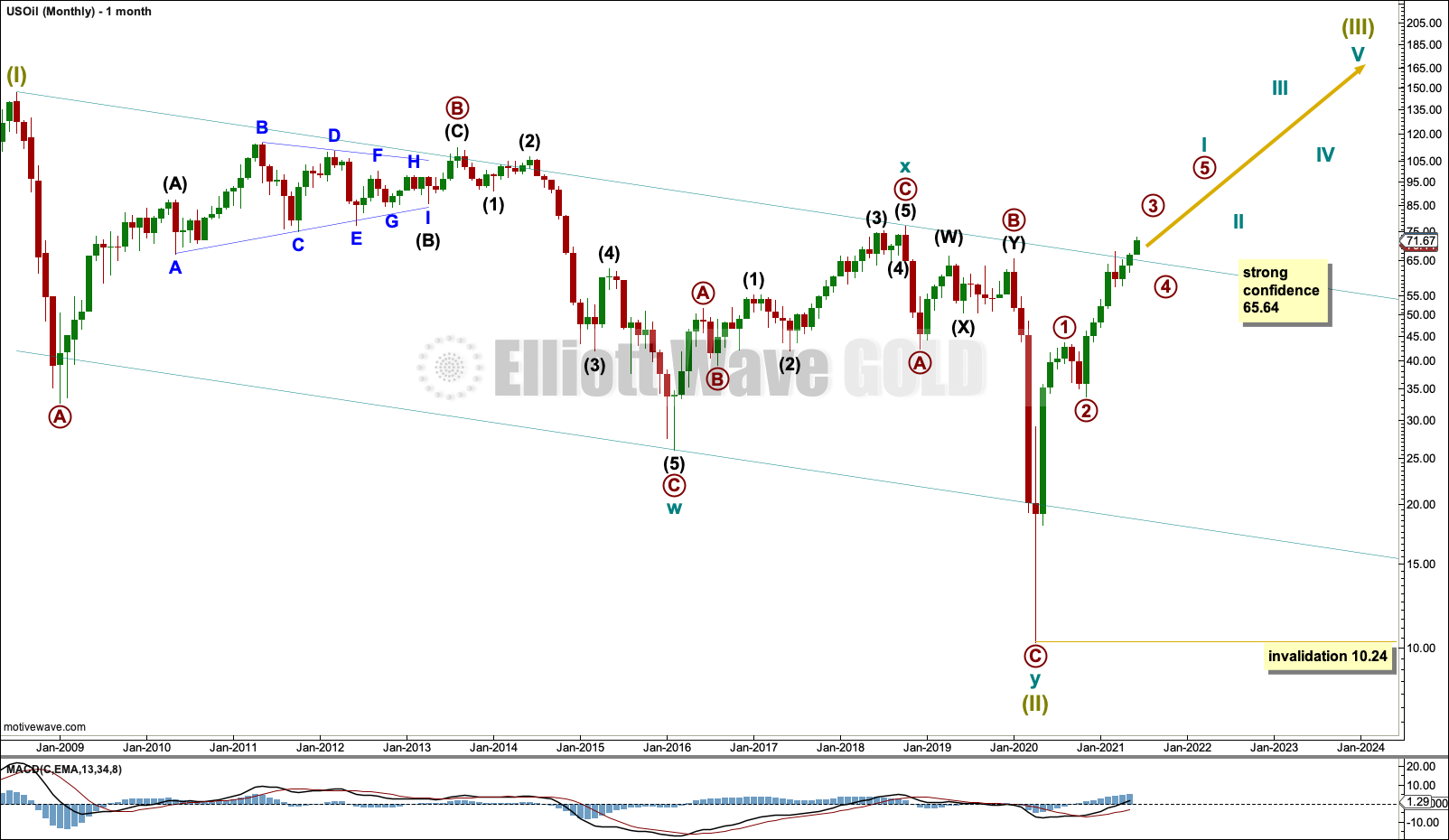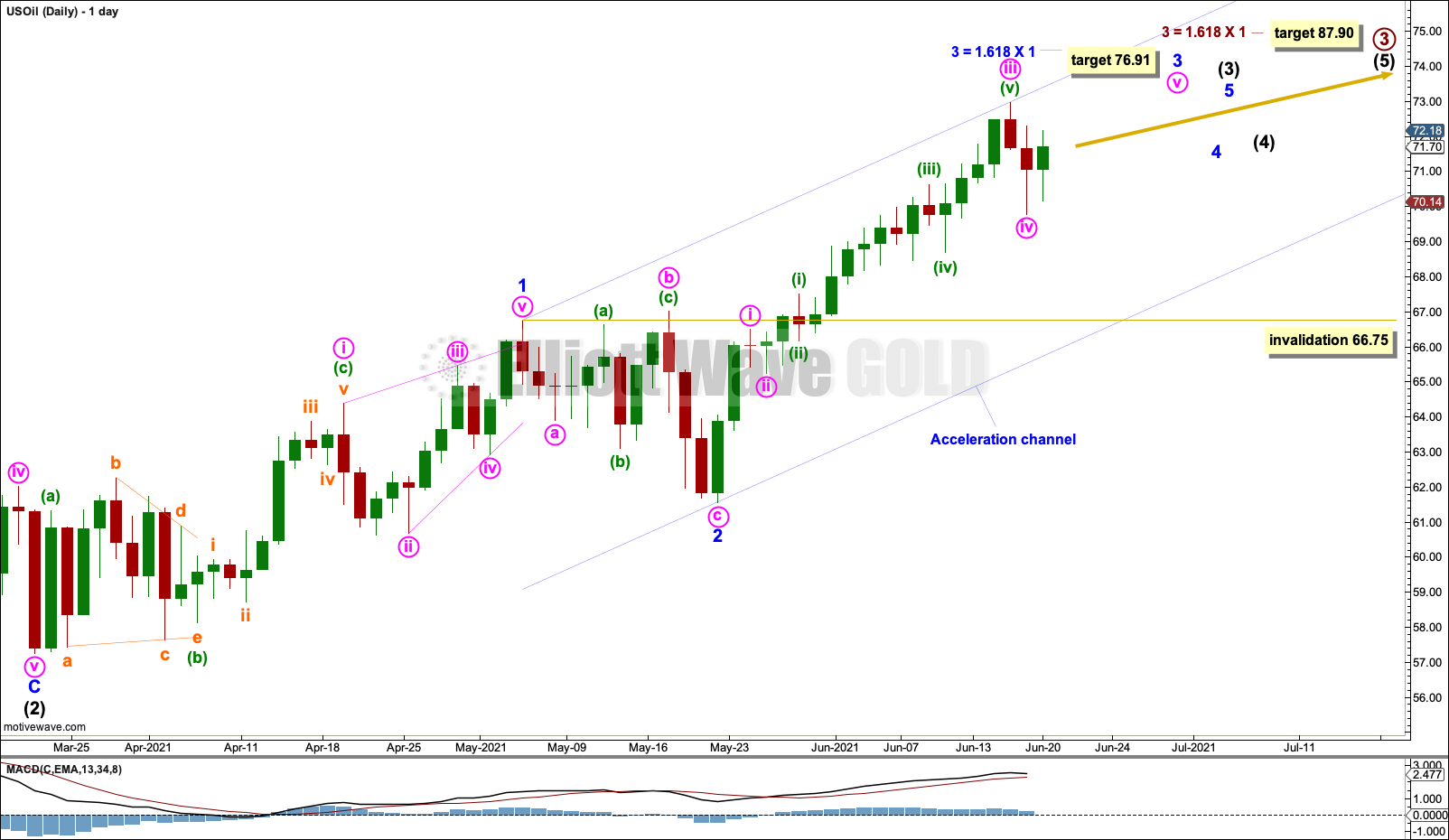Lara’s Weekly: Elliott Wave and Technical Analysis of S&P500 and Gold and US Oil | Charts – June 18, 2021

S&P 500
A channel breach indicated the main Elliott wave count should be discarded in favour of an alternate. Downwards movement was then expected to continue.
Summary: The primary trend remains up. Current downwards movement is expected to be a minor degree fourth wave, which is incomplete.
The wave count expects about two more weeks of overall downwards movement to a target at 4,053.24.
For the short term, expect downwards movement to continue while price remains below 4,188.25. A new high above 4,188.25 would indicate a bounce or consolidation for a B wave may have arrived.
The biggest picture, Grand Super Cycle analysis, is here.
Last monthly charts are here. Video is here.
ELLIOTT WAVE COUNT
WEEKLY CHART
Cycle wave V may last from one to several years. So far it is in its fifteenth month.
This wave count may allow time for the AD line to diverge from price as price makes final highs before the end of the bull market. The AD line most commonly diverges a minimum of 4 months prior to the end of a bull market. A longer divergence is positively correlated with a deeper bear market. A shorter divergence is positively correlated with a more shallow bear market. With zero divergence at this stage, if a surprise bear market does develop here, then it would likely be shallow.
A longer divergence between price and the AD line would be expected towards the end of Grand Super Cycle wave I.
It is possible that cycle wave V may continue until 2029, if the 2020s mirror the 1920s. Either March or October 2029 may be likely months for the bull market to end.
Cycle wave V would most likely subdivide as an impulse. But if overlapping develops, then an ending diagonal should be considered. This chart considers the more common impulse.
There is already a Fibonacci ratio between cycle waves I and III within Super Cycle wave (V). The S&P500 often exhibits a Fibonacci ratio between two of its actionary waves but rarely between all three; it is less likely that cycle wave V would exhibit a Fibonacci ratio. The target for Super Cycle wave (V) to end would best be calculated at primary degree, but that cannot be done until all of primary waves 1, 2, 3 and 4 are complete.
Primary wave 1 within cycle wave V may be incomplete. This gives a very bullish wave count, expecting a long duration for cycle wave V which has not yet passed its middle strongest portion.
Within primary wave 1: Intermediate waves (1) and (2) may be complete, and intermediate wave (3) may now be approaching an end.
Within intermediate wave (3): Minor waves 1 and 2 may be complete, and minor wave 3 may be nearing an end.
Intermediate wave (4) may not move into intermediate wave (1) price territory below 3,588.11.
A best fit channel is drawn about cycle wave V. Draw the first trend line from the end of intermediate wave (1) to the last high, then place a parallel copy on the end of intermediate wave (2). The channel may need to be redrawn as price continues higher. The channel may show where price may find resistance and support along the way up.
When primary wave 1 may be complete, then a multi-month pullback or consolidation may unfold for primary wave 2. It is possible that primary wave 2 may meet the technical definition of a bear market; it may correct to 20% or more of market value.
Primary wave 2 may not move beyond the start of primary wave 1 below 2,191.86.
DAILY CHART
Draw a channel about intermediate wave (3) using Elliott’s first technique. Draw the first trend line from the ends of minor waves 1 to 3, then place a parallel copy on the end of minor wave 2. Minor wave 4 may find support about the lower edge of this channel.
Minor wave 2 lasted 12 sessions and was a relatively shallow 0.31 double zigzag. Minor wave 4 may last about three to five weeks. It may be a shallow time consuming flat, triangle or combination most likely.
Minor wave 4 may not move into minor wave 1 price territory below 3,950.43.
Minor wave 3 within intermediate wave (3) is shorter than minor wave 1. This is unusual for the S&P (which is why this was an alternate until the main wave count was indicated incorrect with a channel breach). It limits minor wave 5 to no longer than equality in length with minor wave 3, which was 533.82 points. When minor wave 4 is complete, then a limit and a target for minor wave 5 to end intermediate wave (3) may be calculated.
TECHNICAL ANALYSIS
WEEKLY CHART

Click chart to enlarge. Chart courtesy of StockCharts.com.
A series of higher highs and higher lows off the low of March 2020 continues. The last short-term swing low is now at 4,056.88. While this remains intact, the dominant view should be of an upwards trend. There is a long way for this trend to run before conditions may become extreme.
A strong downwards week completes a Bearish Engulfing pattern that has push from volume. More downwards movement may be expected as most likely; however, this is not certain. The week beginning 25th January was also a Bearish Engulfing pattern with strong push from volume and was not followed by any more downwards movement.
DAILY CHART
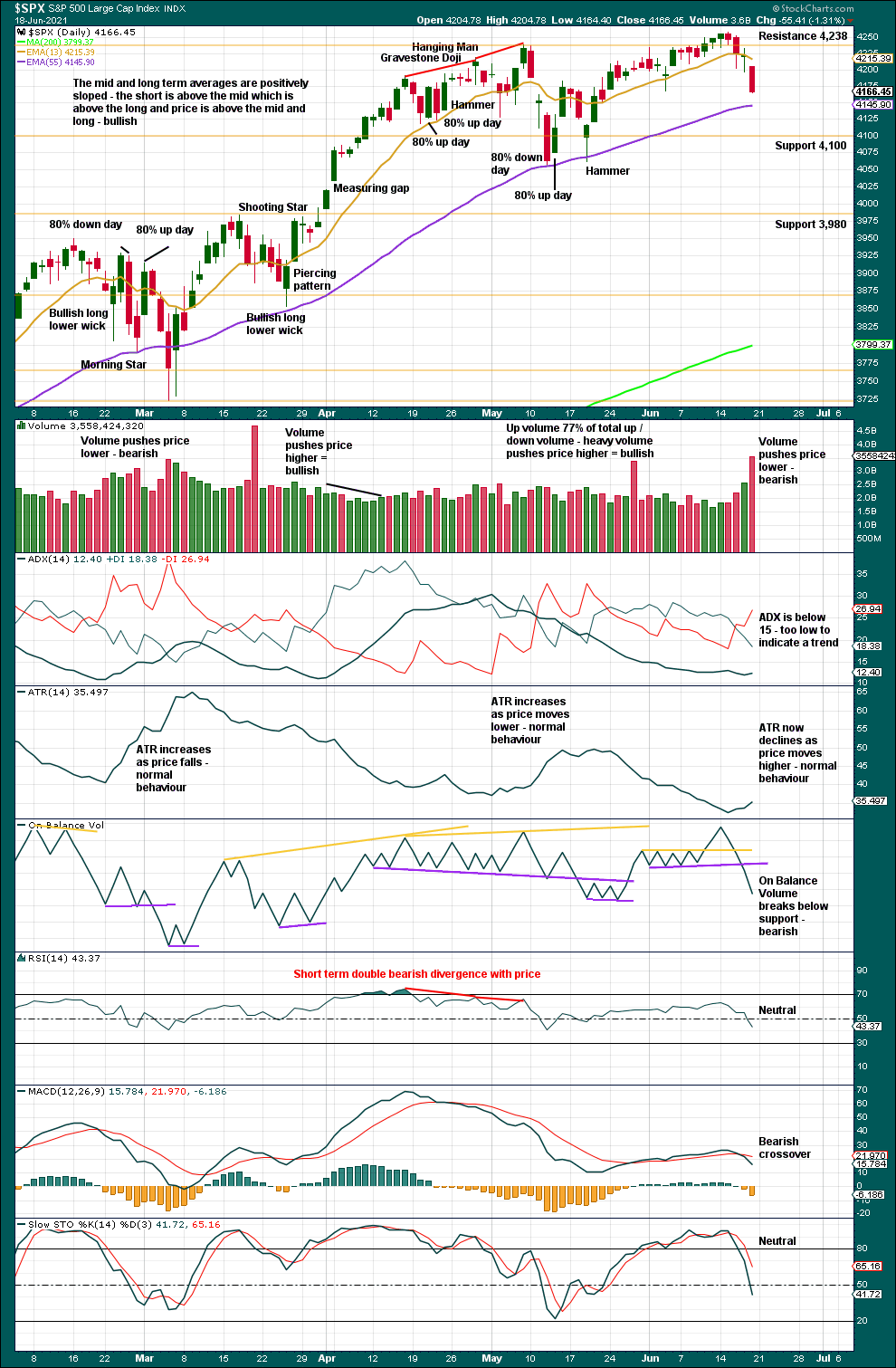
Click chart to enlarge. Chart courtesy of StockCharts.com.
The last swing low is at 4,056.88 on the 12th of May. While price remains above this point, then a series of higher highs and higher lows would remain intact, the basic definition of an upwards trend.
Strong volume and a close to new lows for Friday suggest more downwards movement on Monday.
BREADTH – AD LINE
WEEKLY CHART
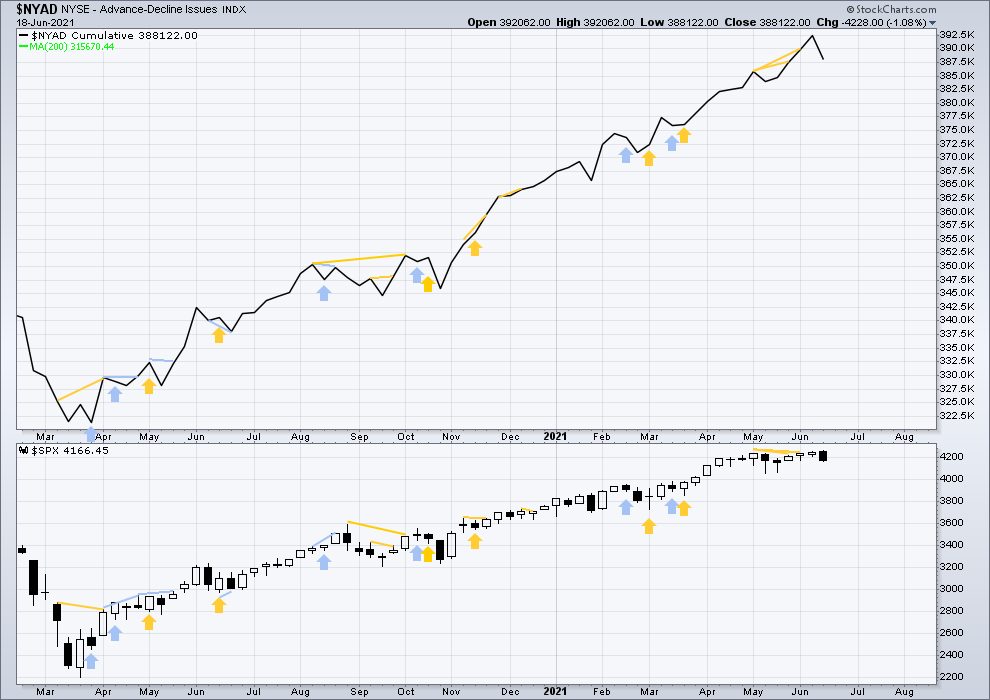
Click chart to enlarge. Chart courtesy of StockCharts.com. So that colour blind members are included, bearish signals will be noted with blue and bullish signals with yellow.
Breadth should be read as a leading indicator.
Lowry’s Operating Companies Only AD line has made a new all time high on the 8th of June. With zero bearish divergence at the last high, any pullbacks here would most likely be short term in nature. Pullbacks in a relatively healthy bull market may be used as buying opportunities.
Large caps all time high: 4,257.16 on Jun 15, 2021.
Mid caps all time high: 2,778.84 on April 29, 2021.
Small caps all time high: 1,417.45 on June 8, 2021.
So far in this pullback it is mid caps which are weakest.
This week both price and the AD line have moved lower. There is no new short-term divergence.
DAILY CHART
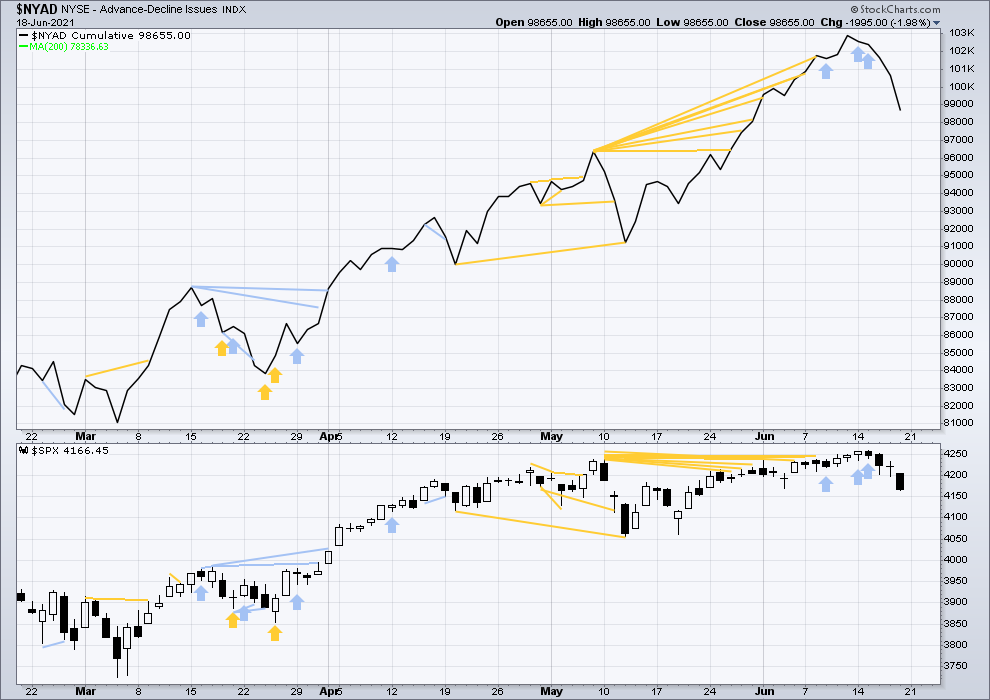
Click chart to enlarge. Chart courtesy of StockCharts.com. So that colour blind members are included, bearish signals will be noted with blue and bullish signals with yellow.
Today both the AD line and price have moved lower. There is no new divergence.
VOLATILITY – INVERTED VIX CHART
WEEKLY CHART
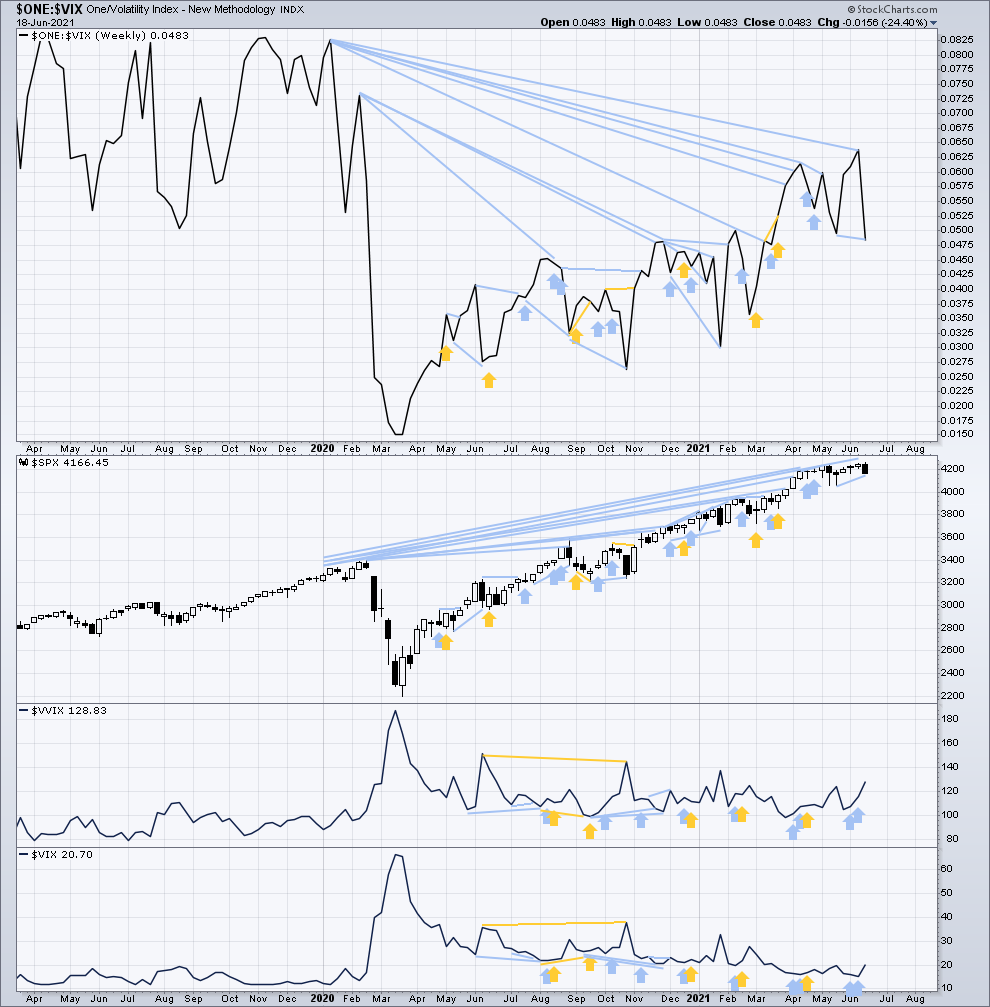
Click chart to enlarge. Chart courtesy of StockCharts.com. So that colour blind members are included, bearish signals will be noted with blue and bullish signals with yellow.
Inverted VIX remains well below all time highs. The all time high for inverted VIX was in the week beginning October 30, 2017. There is over 3 years of bearish divergence between price and inverted VIX. This bearish divergence may develop further before the bull market ends. It may be a very early indicator of an upcoming bear market, but it is not proving to be useful in timing.
This week both price and inverted VIX have moved lower. Inverted VIX has made a new short-term low below the prior low four weeks prior, but price has not. This divergence is bearish and supports the Elliott wave count.
Comparing VIX and VVIX at the weekly chart level:
This week both VIX and VVIX have moved higher. There is no new short-term divergence.
DAILY CHART
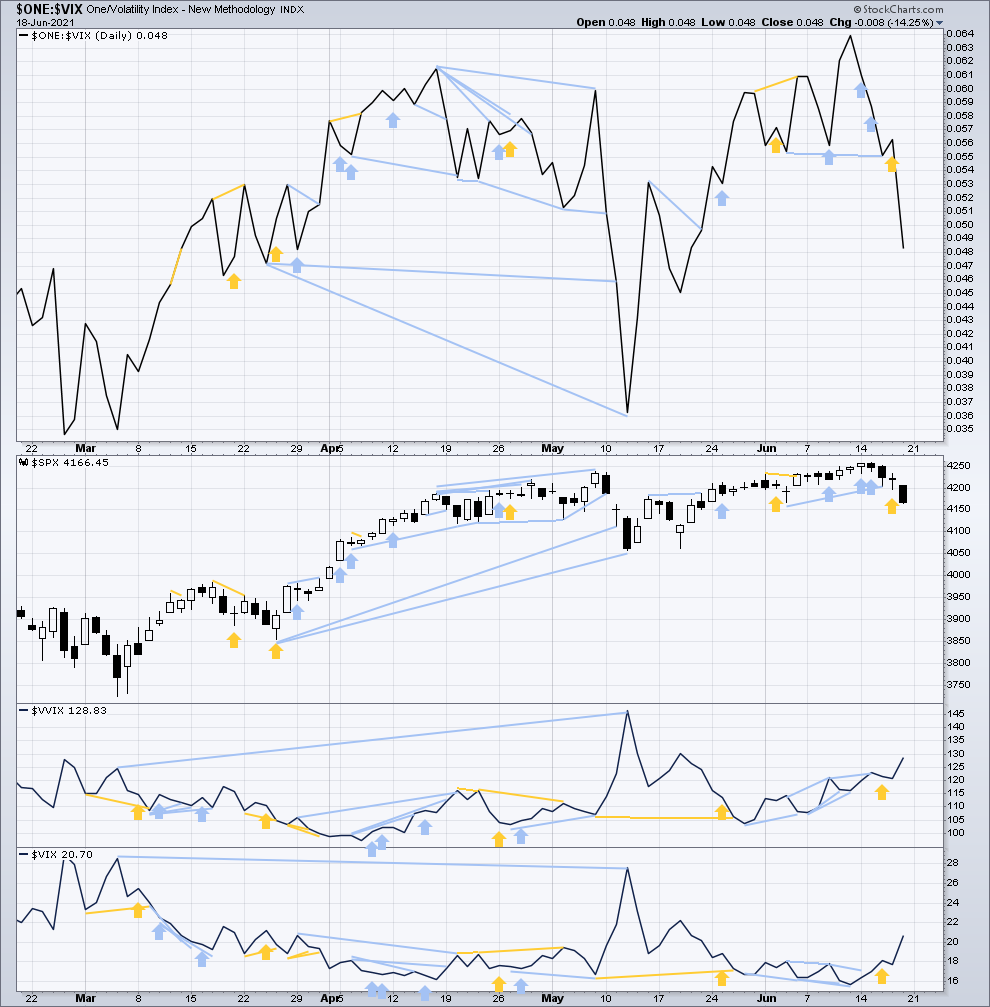
Click chart to enlarge. Chart courtesy of StockCharts.com. So that colour blind members are included, bearish signals will be noted with blue and bullish signals with yellow.
To end the week both price and inverted VIX have moved lower. There is no new divergence between swing lows, but inverted VIX is moving lower more strongly than price, which is bearish.
Comparing VIX and VVIX at the daily chart level:
Both VIX and VVIX have moved higher to end the week. There is no new short-term divergence.
DOW THEORY
Dow Theory confirms a new bull market with new highs made on a closing basis:
DJIA: 29,568.57 – closed above on 16th November 2020.
DJT: 11,623.58 – closed above on 7th October 2020.
Most recently, on 10th May 2021 both DJIA and DJT have made new all time highs. An ongoing bull market is again confirmed by Dow Theory.
Adding in the S&P and Nasdaq for an extended Dow Theory, confirmation of a bull market would require new highs made on a closing basis:
S&P500: 3,393.52 – closed above on 21st August 2020.
Nasdaq: 9,838.37 – closed above on June 8, 2020.
The following major swing lows would need to be seen on a closing basis for Dow Theory to confirm a change from bull to a bear market:
DJIA: 18,213.65
DJT: 6,481.20
Adding in the S&P and Nasdaq for an extended Dow Theory, confirmation of a new bear market would require new lows on a closing basis:
S&P500: 2,191.86
Nasdaq: 6,631.42
GOLD
A new target from yesterday’s analysis at 1,760 has almost been met.
Two Elliott wave counts are used at the end of this week.
Summary: The main wave count expects a final low may be about 1,760. The upwards trend may then resume. A new low below 1,677.64 would see this main wave count invalidated and most likely discarded.
An alternate wave count is very bearish, a target is at 887. A new low below 1,677.64 would provide some confidence in this wave count.
Grand SuperCycle analysis and last monthly charts are here.
MAIN ELLIOTT WAVE COUNT
WEEKLY CHART
This wave count sees the the bear market complete at the last major low for Gold on 3 December 2015.
If Gold is in a new bull market, then it should begin with a five wave structure upwards on the weekly chart.
Cycle wave I fits as a five wave impulse with reasonably proportionate corrections for primary waves 2 and 4.
Cycle wave II fits as a double flat. However, within the first flat correction labelled primary wave W, this wave count needs to ignore what looks like an obvious triangle from July to September 2016 (this can be seen labelled as a triangle on the second weekly chart on prior analysis here). This movement must be labelled as a series of overlapping first and second waves. Ignoring this triangle reduces the probability of this wave count in Elliott wave terms.
Cycle wave IV may be a complete triple zigzag. Triple zigzags are not rare structures, but they are not common. The probability of this wave count is further reduced in Elliott wave terms. This is one reason why an alternate is still considered.
Cycle wave V may have begun. Within cycle wave V: Primary wave 1 may be over at the last high, and primary wave 2 may not move beyond the start of primary wave 1 below 1,677.64.
DAILY CHART
A target is calculated for cycle wave V. If this target is wrong for this wave count, then it may be too low. As price approaches the target, if the structure is incomplete, then a higher target may be calculated.
Primary wave 1 within cycle wave V may be complete.
Primary wave 2 may be expected to most likely be a deep pullback lasting weeks. A target for it is at 1,760.
Primary wave 2 may not move beyond the start of primary wave 1 below 1,677.64.
ALTERNATE ELLIOTT WAVE COUNT
WEEKLY CHART
The bigger picture for this alternate Elliott wave count sees Gold as within a bear market, in a three steps back pattern that is labelled Grand Super Cycle wave IV on monthly charts. Grand Super Cycle wave IV may be subdividing as an expanded flat pattern.
Super Cycle wave (b) within Grand Super Cycle wave IV may be a complete double zigzag. This wave count expects Super Cycle wave (c) to move price below the end of Super Cycle wave (a) at 1,046.27 to avoid a truncation and a very rare running flat. The target calculated expects a common Fibonacci ratio for Super Cycle wave (c).
Super Cycle wave (c) may have begun with a leading expanding diagonal for cycle wave I. Leading expanding diagonals in first wave positions are uncommon, so the probability of this wave count is reduced. However, it has a good fit and must be considered.
Second wave corrections to follow leading diagonals in first wave positions are usually very deep. Cycle wave II is deep and the structure may be complete; so far it is following a common pattern. If it continues higher, then cycle wave II may not move beyond the start of cycle wave I above 2,070.78.
DAILY CHART
Current strong downwards movement may be the very early stages of cycle wave III. A target is calculated for cycle wave III.
Primary wave 1 within cycle wave III may be nearing an end. If intermediate wave (4) within primary wave 1 continues higher, then it may not move into intermediate wave (1) price territory above 1,861.17.
Draw an Elliott channel about primary wave 1. When this channel is breached by upwards movement, then that may be used as an indication that primary wave 1 should be over and primary wave 2 may then be underway.
TECHNICAL ANALYSIS
WEEKLY CHART

Click chart to enlarge. Chart courtesy of StockCharts.com.
The upwards trend may have ended, for now. There is now a bearish candlestick reversal pattern in a Hanging Man that has bearish confirmation in the following candlestick.
Now a strong downwards week closes near the low. This suggests more downwards movement next week.
DAILY CHART
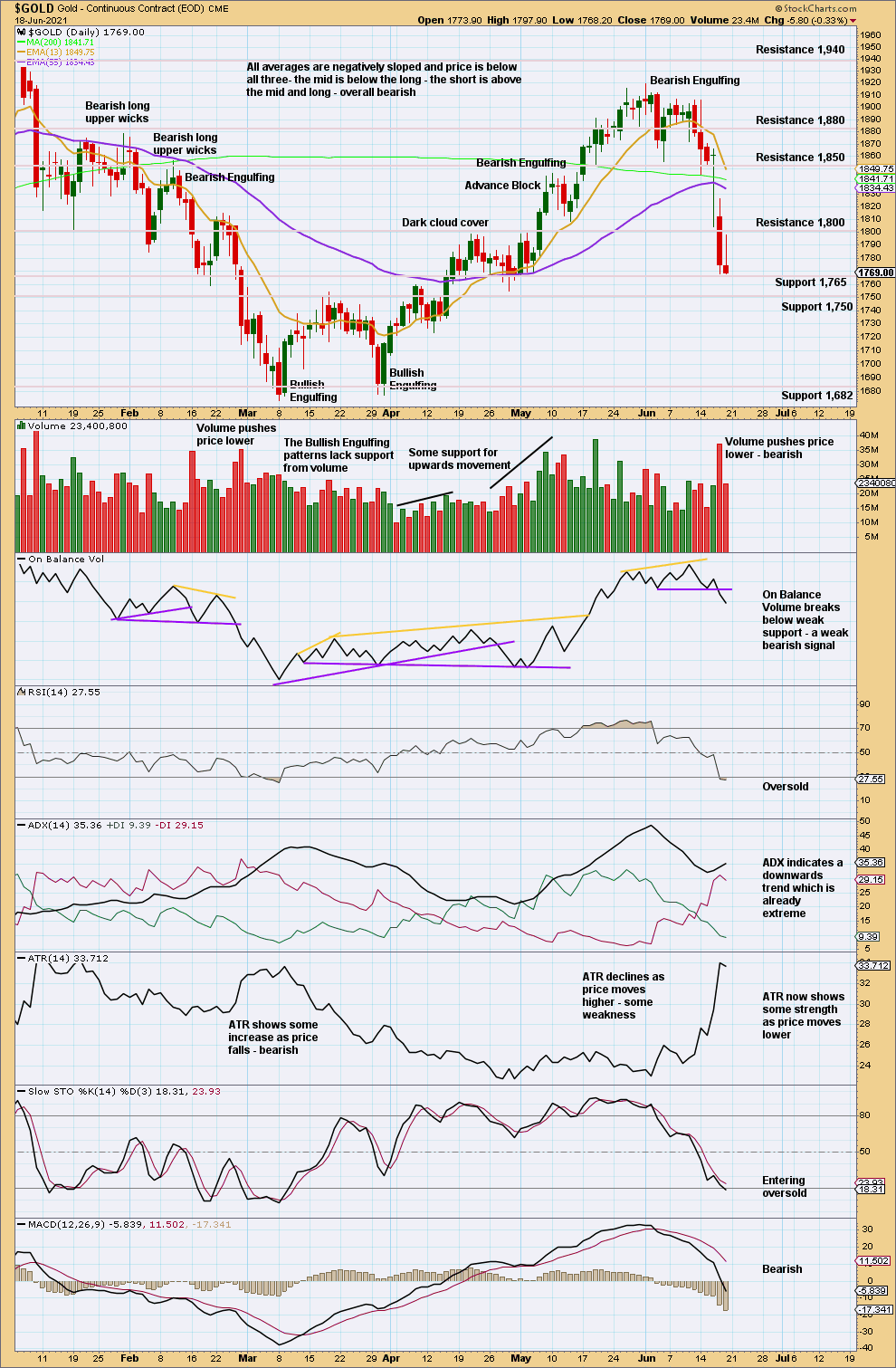
Click chart to enlarge. Chart courtesy of StockCharts.com.
If next support about 1,765 is breached, then this downwards movement may end about 1,750.
The small real body on the last candlestick suggests some weakness, but the long upper wick and close near the low is bearish. A bounce will come soon, but not quite yet.
GDX WEEKLY CHART
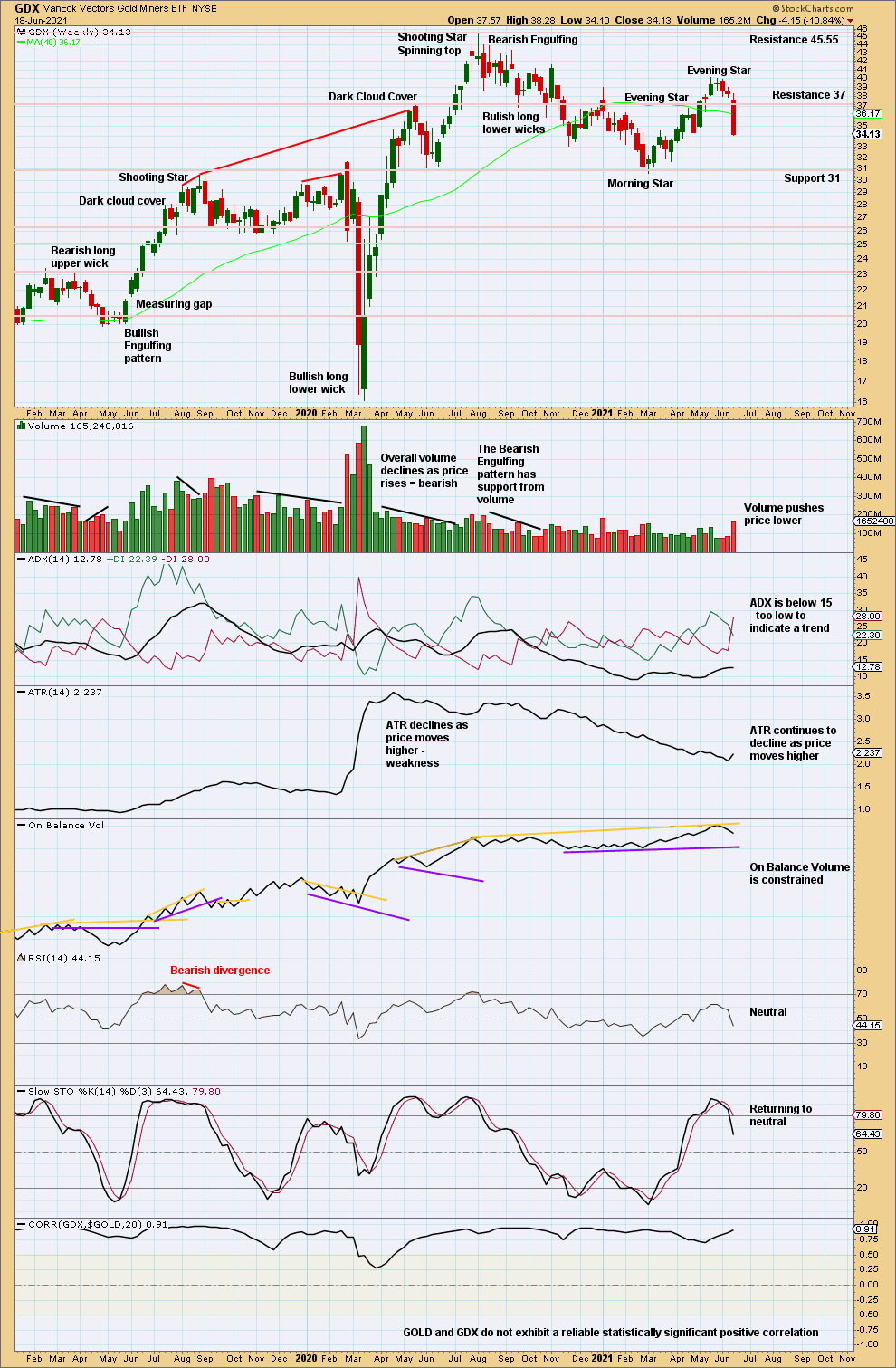
Click chart to enlarge. Chart courtesy of StockCharts.com.
A strong downwards week that has push from volume and closes new lows is bearish for next week.
GDX DAILY CHART
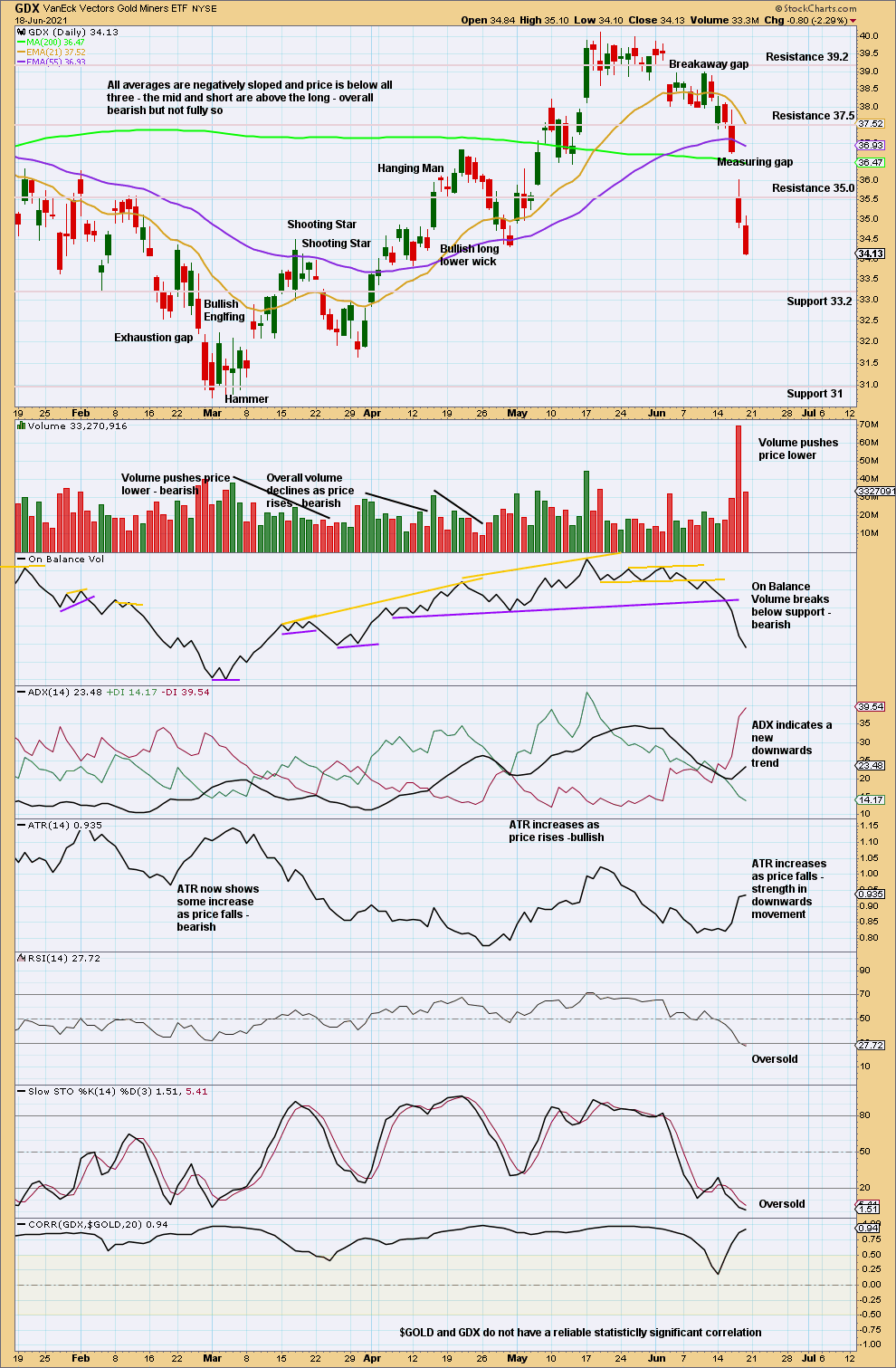
Click chart to enlarge. Chart courtesy of StockCharts.com.
The measuring gap gives a target at 33.78.
US OIL
Upwards movement continues for another week.
The Elliott wave target remains the same.
Summary: The Elliott wave count expects upwards movement to continue to a short-term target at 76.91, with a longer term target at 87.90.
Oil may have found a major sustainable low in April 2020.
ELLIOTT WAVE COUNT
MONTHLY CHART
The basic Elliott wave structure is five steps forward and three steps back. This Elliott wave count expects that US Oil has completed a three steps back pattern, which began in July 2008. The Elliott wave count expects that the bear market for US Oil may now be over.
Following Super Cycle wave (II), which was a correction (three steps back), Super Cycle wave (III), which may have begun, should be five steps up when complete. Super Cycle wave (III) may last a generation and must make a new high above the end of Super Cycle wave (I) at 146.73.
A channel is drawn about Super Cycle wave (II): draw the first trend line from the start of cycle wave w to the end of cycle wave x, then place a parallel copy on the end of cycle wave w. This trend line is breached to the downside, which is a typical look for the end of a movement for a commodity.
The upper edge of the channel may provide resistance. Price is reacting down from the upper edge of this channel.
Super Cycle wave (III) may only subdivide as a five wave impulse. New trends for Oil usually start out very slowly with short first waves and deep time consuming second wave corrections. However, while this is a common tendency, it is not always seen and may not have been seen in this instance. The first reasonably sized pullback may be over already.
WEEKLY CHART
Super Cycle wave (III) must subdivide as an impulse.
Cycle wave I within Super Cycle wave (III) may be incomplete.
Within cycle wave I: Primary waves 1 and 2 may be complete, and primary wave 3, which may only subdivide as an impulse, may have begun.
Within primary wave 3: Intermediate waves (1) and (2) may be complete. No second wave correction within intermediate wave (3) may move beyond its start below 57.26.
DAILY CHART
It is possible that intermediate wave (2) was over as a brief and shallow zigzag.
If intermediate wave (3) has begun, then minor wave 1 within it may be a complete leading contracting diagonal. Following a leading diagonal in a first wave position, the second wave correction is usually very deep. Minor wave 2 is a 0.55 depth of minor wave 1.
When a first wave subdivides as a leading diagonal, then the third wave is almost always extended. The target expects this common scenario.
A target is calculated for minor wave 3 that expects it to exhibit a common Fibonacci ratio to minor wave 1. Minor wave 4 may not move into minor wave 1 price territory below 66.75.
Draw an acceleration channel about intermediate wave (3). Draw the first trend line from the end of minor wave 1 to the last high, then place a parallel copy on the end of minor wave 2. Keep redrawing the channel as price continues higher. When minor wave 3 may be over, then this channel would be drawn using Elliott’s first technique and may show were minor wave 4 may find support.
TECHNICAL ANALYSIS
WEEKLY CHART

Click chart to enlarge. Chart courtesy of StockCharts.com.
Volume and On Balance Volume support the Elliott wave count. This market can sustain extreme trends for a reasonable period of time.
DAILY CHART

Click chart to enlarge. Chart courtesy of StockCharts.com.
After a downwards session, ADX no longer indicates a trend. If upwards movement resumes, then ADX would again increase and indicate an upwards trend in an early stage. The only concern here is declining ATR, as price continues higher indicates weakness.
—
Always practice good risk management as the most important aspect of trading. Always trade with stops and invest only 1-5% of equity on any one trade. Failure to manage risk is the most common mistake new traders make.
—



